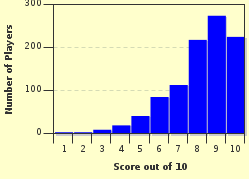Quiz Answer Key and Fun Facts
1. Song Number 10: "You know I feel so dirty when they start talking cute"
This song about a guy pining for his best friend's gal was inspired by the singer's real life experience. Do you remember the hit that soap opera star Rick Springfield took to number one in the summer of 1981?
2. Song Number 9: "Are you ready? Are you ready for this? Are you hanging on the edge of your seat?"
The entire nation was on the edge of its seat when this song became the all-time biggest hit in the United States for the rock group Queen. What classic song did they take to number one in October of 1980?
3. Song Number 8: "Roll me in designer sheets. I never get enough"
This song has quite a pedigree: Number one song of 1980. On Rolling Stone's list of the 500 Greatest Songs of All Time. Performed by a recording act who was inducted into the Rock 'n Roll Hall of Fame in 2006. Can you name this hit single in which Blondie sings the title in French, Italian and, of course, English?
4. Song Number 7: "Those soft and fuzzy sweaters. Too magical to touch"
This song about seeing your high school crush's picture in a magazine captivated America in the spring of 1982. Spending six weeks at the top, what smash hit about "my homeroom angel" left everybody's "blood running cold"?
5. Song Number 6: "Risin' up, straight to the top, had the guts, got the glory"
I spent most of the summer of '82 blasting this song from a tape recorder while my friends and I reenacted scenes from the movie it came from. I must say I played a mean Clubber Lang. What adrenaline-pumping classic did Survivor take to number one for six weeks that year?
6. Song Number 5: "Now I hear the music, close my eyes, I am rhythm"
This song came from a movie that reached out to all those female welders who long dreamed of dousing themselves on stage with a pail of water. Apparently a largely underrepresented group, they and the rest of America kept this hit on top for six weeks in 1983. From what movie did Irene Cara sing this title song?
7. Song Number 4: "I dream at night, I can only see your face"
Regarded as a sweet love song by many of its fans, this monster hit has been called by its writer and singer a "nasty song" all about "ownership and jealousy". Can you name this smash that Billboard named the number one song of 1983?
8. Song Number 3: "I'll hold you in my arms. I can't resist your charms"
As one of the most popular love songs of the 1980s, this single remained at number one for an amazing nine weeks in 1981 and became the biggest pop hit for Motown records. Do you remember who sang "Endless Love", the biggest movie soundtrack song of the decade?
9. Song Number 2: "She's pure as New York snow"
Originally recorded by Jackie DeShannon in 1975 as a honky-tonk tune, this song didn't initially impress singer Kim Carnes. It was only when musician Bill Cuomo created an arrangement with a new synthesizer feel did she go, "That's it! No shadow of a doubt!" and she knew she had a hit. What song did she keep at number one for nine weeks in the spring/summer of 1981?
10. Song Number 1: "There's nothing left to talk about, unless it's horizontally"
The number one song of the 1980's spent an astonishing ten weeks at number one in 1981/1982 and helped inspire a fitness craze across the world. Banned on some radio stations at the time, the song and its suggestive lyrics roughed up the squeaky clean image of the woman who sang it.
Can you recall what word was substituted for the title during the last chorus of Olivia Newton-John's biggest hit?
Source: Author
bottle_rocket
This quiz was reviewed by FunTrivia editor
Dalgleish before going online.
Any errors found in FunTrivia content are routinely corrected through our feedback system.

